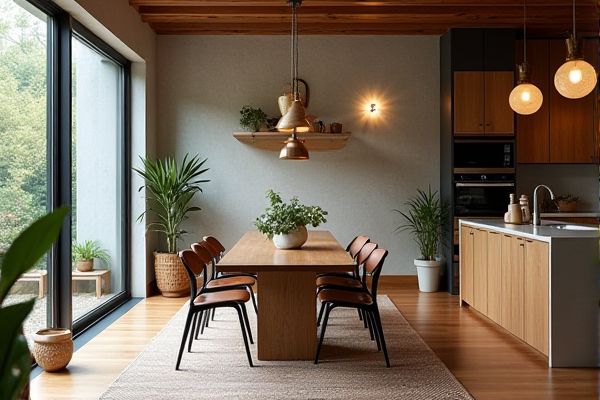
Mid-century modern dining spaces emphasize clean lines, organic shapes, and warm wood tones to create an inviting and timeless atmosphere, while industrial dining rooms showcase raw materials like metal, exposed brick, and rustic finishes for a bold, urban edge. Discover how your dining area can seamlessly blend style and functionality by exploring these two distinct design aesthetics in detail.
Table of Comparison
| Feature | Mid-Century Modern Dining | Industrial Dining |
|---|---|---|
| Design Style | Organic shapes, clean lines, minimalism | Raw, rugged, utilitarian |
| Materials | Teak wood, walnut, fiberglass, leather | Metal, reclaimed wood, concrete, exposed brick |
| Color Palette | Earthy tones, muted colors, pastels | Neutral grays, blacks, browns |
| Furniture | Streamlined chairs, tapered legs, molded shapes | Sturdy metal frames, factory-style stools, distressed wood |
| Lighting | Sputnik chandeliers, pendant lights with clean design | Exposed bulbs, metal cage fixtures, vintage pendants |
| Ambiance | Warm, inviting, retro-futuristic | Edgy, raw, urban |
| Popular Elements | Teak dining tables, Eames chairs, minimalist decor | Reclaimed wood tables, factory carts, exposed pipes |
Understanding Mid-Century Modern Dining Style
Mid-century modern dining style emphasizes clean lines, organic curves, and a minimalist approach that combines functionality with elegance, often featuring natural wood tones and simple silhouettes. This style contrasts with industrial dining, which incorporates raw materials like metal and exposed brick, creating a rugged, urban aesthetic. Understanding these differences helps you select a dining design that complements your space and personal taste effectively.
Key Features of Industrial Dining Design
Industrial dining design features raw materials like exposed brick, metal fixtures, and reclaimed wood, creating a rugged yet functional aesthetic. This style emphasizes open space, utilitarian furniture, and neutral color palettes dominated by grays, blacks, and browns. Vintage-inspired lighting and metal accents contribute to the industrial look, blending practicality with an urban, loft-like vibe.
Historical Origins of Both Styles
Mid-century modern dining design originated in the mid-20th century, emphasizing clean lines, organic curves, and functional furniture inspired by post-war optimism and Scandinavian influences. Industrial dining style emerged from early 20th-century factory and warehouse aesthetics, showcasing raw materials like exposed brick, metal, and reclaimed wood to evoke a rugged, utilitarian vibe. Your choice between these styles reflects a preference for either the sleek, minimalist ethos of mid-century modern or the edgy, unfinished character of industrial design.
Color Palettes: Warm vs Cool Tones
Mid-century modern dining spaces emphasize warm tones with hues like mustard yellow, olive green, and rich wood finishes that create a cozy, inviting atmosphere. Industrial dining areas favor cool tones such as grays, blacks, and metallics, highlighting raw materials like steel and exposed brick for an urban, edgy aesthetic. The choice between warm and cool color palettes heavily influences the mood and visual appeal of the dining environment.
Material Choices in Each Dining Style
Mid-century modern dining emphasizes natural materials like teak, walnut, and oak, paired with sleek, smooth finishes that highlight organic textures and warm tones. Industrial dining favors robust, utilitarian materials such as exposed steel, reclaimed wood, and concrete surfaces, creating a more rugged, urban aesthetic. Your choice between these styles depends on whether you prefer the warmth and elegance of mid-century modern or the raw, edgy feel of industrial design.
Furniture Design: Shapes and Lines
Mid-century modern dining furniture features clean, organic shapes with smooth, tapered lines that emphasize simplicity and functionality, often incorporating natural materials like wood. Industrial dining design, however, showcases robust, angular shapes with exposed metal accents and raw finishes, highlighting utilitarian and rugged aesthetics. Your choice between these styles depends on whether you prefer the warm, streamlined elegance of mid-century modern or the bold, edgy character of industrial design.
Lighting Solutions: Statement Pieces
Mid-century modern dining lighting solutions emphasize sleek, organic shapes with iconic statement pieces like Sputnik chandeliers or globe pendants that blend form and function seamlessly. Industrial dining spaces feature bold, utilitarian lighting such as exposed Edison bulbs, metal cage pendants, and factory-inspired fixtures that create a rugged yet stylish atmosphere. Both styles rely on statement lighting to anchor the dining area but differ in material and design language, with mid-century favoring smooth curves and warmth, while industrial embraces raw metal and vintage aesthetics.
Decor and Accessory Differences
Mid-century modern dining decor emphasizes clean lines, organic shapes, and natural materials such as teak and walnut, often featuring minimalist accessories like geometric vases and abstract art. Industrial dining decor incorporates raw elements like exposed brick, metal fixtures, and reclaimed wood, complemented by utilitarian accessories such as Edison bulbs, metal trays, and vintage signage. The contrast lies in mid-century's sleek simplicity versus industrial's rugged, functional aesthetic.
Creating Atmosphere: Comfort vs Functionality
Mid-century modern dining emphasizes comfort through organic shapes, warm wood tones, and soft upholstery, creating an inviting atmosphere ideal for relaxed gatherings. Industrial dining prioritizes functionality with minimalist design, exposed metal, and utilitarian materials, fostering a raw, edgy environment suited for efficient use of space. You can choose mid-century modern for cozy dining experiences or industrial for a practical, modern aesthetic.
Choosing the Right Style for Your Home
Mid-century modern dining furniture features clean lines, organic curves, and warm wood tones that create a timeless and inviting atmosphere, ideal for homes seeking a blend of retro charm and functional elegance. Industrial dining styles emphasize raw materials like metal, exposed steel, and reclaimed wood, offering a rugged, urban aesthetic suited for lofts or contemporary spaces with a minimalist approach. Selecting between mid-century modern and industrial dining depends on your home's overall design theme, color palette, and preference for either a cozy, nostalgic vibe or an edgy, industrial feel.
 homyna.com
homyna.com